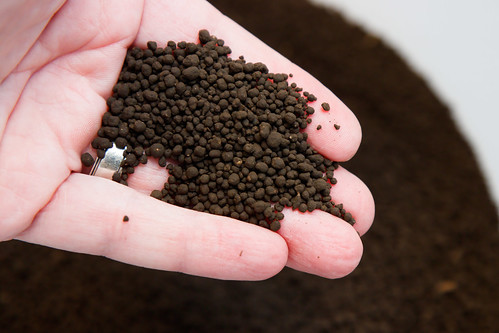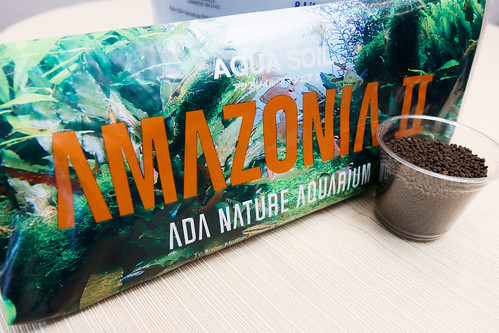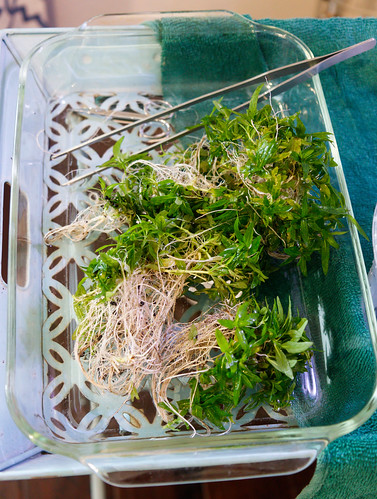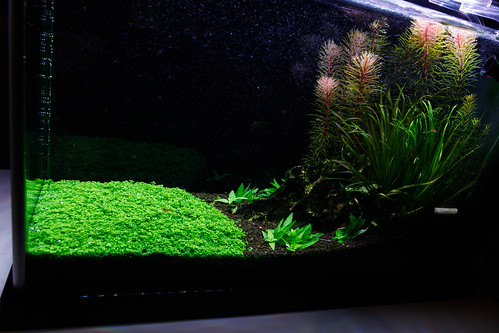Every year or two (or three) I get the itch to breakdown the planted Spec V aquarium. About a year ago, I went through this process and decided that with all the effort involved in a rescape, I would try out some new substrate.
Anyone involved with planted tanks eventually comes across the beautiful products and creations of Takashi Amano, a pioneer of freshwater aquascaping and the founder of Aqua Design Amano (ADA).
Among equipment invented and sold from his company (sleek rimless aquariums, CO2 accessories and light equipment), ADA is known for producing substrate created specifically for planted tanks.
I will discuss my experience of using ADA Amazonia II for the past year and I will compare to the Up Aqua AquaSand substrate that we we used previously. As a bonus, I will also give an overview of other ADA substrates in their lineup.
Amazonia II Substrate Appearance and Description:
Amazonia II substrate is made up of tiny spheres. The exact makeup is unknown (by me), but it is essentially fortified dirt/clay that is compacted and baked for durability and longevity in a planted aquarium. The sphere size varies a bit with most being the same size but a few tiny pieces mixed in.
The substrate color is near black. If there is any hint of brown in the color, it tends to disappear (and appear darker) inside a tank with water.
I noticed there were a few random stick like pieces and some lighter colored bits mixed in. This is very different than the Up Aqua AquaSand I have used previously (which is extremely uniform).
I don’t mind a little variety both in color and grain size. The photo below is a comparison, with Amazonia II on the left and Up Aqua AquaSand on the right:
The bag I purchased was advertised as 9 Liters. I checked and the bag measured out to 8 Liters in volume. Whoops! Looks like ADA is shorting their customers by about 12%. I don’t care for this practice at all – It doesn’t seem that complicated for a manufacturer to actually put in the bag the volume that is advertised.
If you are wondering how many bags you need to purchase for your tank, check out my substrate calculator. The 9 Liter bag was way more than we needed for our nano aquarium. I stored the remaining substrate in ziplock bags for future use. Amazonia II is also available in a 3 Liter Bag.
My Experience with Amazonia II Substrate:
I’ve been using ADA Amazonia II in our planted Spec V for a little over a year now. I had a few concerns moving from Up Aqua Aquasand, both being rumored issues of ADA Amazonia: Longevity and Ammonia.
Amazonia II Durability / Longevity:
The first concern is that Amazonia breaks down and turns to ‘mud’ over time. Throughout this first year, I have not seen this to be the case. The substrate does collect some detritus and does break down some over time – this is evident when I uproot plants and a dirt cloud ensues.
However, I don’t consider substrate breakdown to be an issue until it is widespread and causes the dirt to become dense and compacted with no place for voids. Our Amazonia II has not gotten anywhere near that point. It is holding up the same as what I observed from Up Aqua AquaSand.
I will report back over time on the longevity of this substrate.
Amazonia II and Ammonia Leaching:
The second issue is leaching or forming excessive ammonia at setup. With startup of our Amazonia II substrate, I only tested positive for ammonia for the first three days (1.0 ppm). Even then, I’m not convinced this was the case as I was using an old test kit. After the first three days of positive tests, I used a nicer (and newer) Salifert ammonia test kit and it tested (on day 4) as 0 ppm of ammonia. So, worst case is that I had ammonia for 3 days. Best case (if the API test kit I was using was reporting false) is there was no ammonia.
One thing to note is that in my case, I was performing a Rescape and had plenty of established filter material (full of beneficial bacteria) that worked to break down the ammonia released from the new Amazonia II substrate. I could tell this was happening as my Nitrates (the end product of those beneficial bacteria) rose quickly in the first week.
I’d suggest if you are setting up a new tank that you take care to monitor ammonia throughout the cycling process to make sure ammonia is being fully processed before you add your livestock.
If you are performing a rescape and already have seeded filter material, the ammonia should be processed and not build up (once the bacteria colonies ramp up to match the new ammonia load). For the care of your livestock, keep them quarantined separate for a week to be sure ammonia doesn’t spike in the new setup, and perform large water changes as needed to keep nitrate levels in check.
Amazonia II Performance – Plant Growth and Health:
This is the main reason I wanted to try a substrate from ADA – I wanted to see if the plants would grow faster and be healthier.
I can honestly say I think Amazonia II has proven to be noticeably better in this respect when compared to Up Aqua Aquasand. Both are in the same class of aquarium substrates (dirt/clay based for plant growth) but it seemed that my plant growth took off with Amazonia.
This was especially evident from root growth. I have to uproot our Blyxa Japonica ever 3 weeks or so. When I replant, the bunch as trimmed roots. At the end of it’s growth period, when I pull up plants to thin them out, the root growth is amazing.
I’ve observed the same root growth when uprooting and replanting the Staurogyne Repens:
My carpet plant, Hemianthus callitrichoides (HC Cuba), had no problem taking root (important to keep it in place) and spreading like wildfire.
Amazonia II – Comparison to Other Substrates:
I only have two points of reference for comparison. I have used Seachem Flourite initially in our Spec V. There really is no comparison as Flourite is inert and offers very little in the way of nutrients for plant growth.
As I spoke to in the previous section, compared to Up Aqua Aquasand, it’s comparable with slightly better root growth.
Aesthetically, It’s a beautiful substrate that looks good now and after some usage.
ADA Amazonia Lineup and Variants:
ADA makes a number of other substrate variants. I don’t have experience beyond Amazonia II, but I will present what I know of the other choices.
I’m going to use the following categories to try and illustrate differences in their product line:
- Grain Size (Large, Medium, Fine)
- Color
- Nutrients (High, Medium, Low)
- Ammonia Leaching Risk (High, Medium, Low)
ADA Amazonia (Original):
- Grain Size – Medium
- Color – Dark
- Nutrients – High
- Ammonia Leaching Risk – High
Amazonia is dark in color and granular in texture. It is specifically made to establish and maintain growth of aquatic plants in a high tech (fast growing) setup.
I found a good article at Aqua Journal Online Magazine. that describes the ADA Amazonia line of substrate:
“The greatest feature of Amazonia is in promoting the growth of aquatic plants. The secret is in its base material – natural black soil containing rich nitrogen and organic compounds. But it does not mean that any black soil will do. The base soil used for Amazonia is very rare, relatively sticky black soil rich in plant-derived compounds and it greatly differ from ordinary black volcanic ash soils.
Nitrogen content is a major factor that determines the growth rate of aquatic plants. Amazonia contains outstandingly rich nitrogen and immediately after it is laid in aquarium, a large amount of ammonium (NH4) leaches into water. Ammonium is not toxic to fish and shrimps; however in an environment where pH level is higher than neutral (above 7.0), ammonium is converted into highly-toxic ammonia (NH3) or into nitrite (NO2) in the nitrification process driven by nitrifying bacteria which convert ammonium into highly-toxic nitrates (NO3). Therefore, it is not recommended to add fish or shrimp to an aquarium which is still in the initial stage where ammonium level is high.”
I quoted this because I could not describe any better (although describing “highly toxic nitrates” is confusing – maybe Nitrites was intended). The biggest challenge of Amazonia is the production of Ammonia at tank setup. As described in the quote, It is not recommended to have fish in a tank new setup with Amazonia until ammonia levels decline to zero. I don’t have direct experience with this substrate, but I would imagine could take longer than what I experienced with Amazonia II. Large water changes may be necessary during startup of an Amazonia tank to keep ammonia and nitrate levels from becoming sky high.
ADA Amazonia II:
- Grain Size – Medium
- Color – Dark
- Nutrients – Medium/High
- Ammonia Leaching Risk – Low/Medium
This is a revised version of Amazonia (original) that I’m pretty sure ADA introduced to deal with the high ammonia issues. It is slightly lower in nitrogen content and leaches less ammonia. However, it still leaches some and you will be advised to avoid adding fish to a tank newly established with this substrate until ammonia test at 0 ppm.
ADA Africana and Malaya:
- Grain Size – Medium
- Color – reddish (Africana) / tannish (Malaya)
- Nutrients – Low / Medium
- Ammonia Leaching Risk – Low
ADA’s Africana and Malaya move further down the nutrient scale and thus have even fewer issues with ammonia leaching.
With less nitrogen, this substrate is designed for use in low to medium light tanks with slower growing plants. However, I see no reason this couldn’t be used in a high tech planted (high light with CO2 injection) since you will be adding fertilizers anyway to be the primary plant nutrients.
ADA Aqua Soil Amazonia Powder Type :
:
- Grain Size – Fine
- Color – Dark
- Nutrients – High
- Ammonia Leaching Risk – High
This ADA variant seems to be the same as Amazonia (Original) but with a smaller grain size. It is purportedly better for carpeting plants, but I have demonstrated with our tank that the ADA standard grain size works fine.
Conclusions for ADA Amazonia II Review:
I’m a fan of Amazonia II and plan on using it for along time. It has a great appearance, is as durable as I need a substrate to be, and plant health and growth are very good. It is costly on first glance, but comparing on a volume basis, it is comparable to other substrates. I feel it is worth the cost, especially for a planted nano.
Based on the great performance, I see no need to ever try Amazonia (original) as I don’t need the higher nutrients (and possible ammonia spike at setup).
I don’t see a need for Amazonia Powder as my carpet grass does just fine in the larger grained Amazonia (II) and I like the appearance better.
If I was to try one other variant, it would be ADA Malaya. This wold solely be to try out an0ther color (tan) for an aesthetic change.














Thank you. Great Article and exactly the knowledgeable info I was looking for ✅
I appreciate that – you are very welcome!
What kinds of plants are you using in this setup? Referring to the picture of the full tank with HC Cuba and some stems?
The plants you see in the photo are the same four plants I have in there now:
Rotala Wallichii
Blyxa Japonica
Staurogyne Repens
Hemianthus Callitrichoides (HC Cuba)
I appreciate your careful, informative review of ADA soils. I’m looking forward to reading your next article.
Word of warning: after a year or two this stuff becomes a huge problem if it’s your surface-level substrate. It degrades into a very fine dust that is constantly getting kicked up by fish movement and cycling through the water column. My tank looked like nuclear winter, with ash-like dust falling over the plants constantly, and nothing rooting well in the degraded ADA. Adding fresh ADA only made the problem worse, as it too began to degrade.
I just red-did my substrate, sandwiching a thin layer of new Aquasoil between inert Fluorite gravel on the bottom and fine sand on top. Hopefully that gives plants access to the good nutrient will preventing climate catastrophe in the future.
It does break down over time, but I haven’t experienced anything near what you are describing.
No way would I ever mix substrates of different weights/sizes. They will separate over time and you will end up with a big mess. I think it’s understood Amazonia doesn’t last forever and if replacement is an issue, just use something like Fluorite.
Nice write up on ADA Soil. Is the ADA Amazonia v2 comparable to Amazonia II in terms of ammonia leeching? The guy in the shop said amazonia v2 is currently the lowest ammonia leeching soil from ADA when not using the root tabs, as the light version is not produced anymore.
Great question and it’s surprisingly difficult to understand the difference between Amazonia II (reviewed here) and Amazonia V2 (a newer product). ADA North America has an article here that tries (and fails) to describe the difference.
It sounds like Amazonia V2 retains Amazonia II’s low ammonia leaching properties but boosts the nutrients a bit.
I’d say the person you spoke with is most likely correct – Amazonia V2 is the current best option to avoid excessive ammonia at tank startup (that happened with Amazonia original).